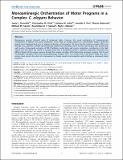| dc.contributor.author | Donnelly, Jamie L. | |
| dc.contributor.author | Clark, Christopher M. | |
| dc.contributor.author | Leifer, Andrew M. | |
| dc.contributor.author | Pirri, Jennifer K. | |
| dc.contributor.author | Haburcak, Marian | |
| dc.contributor.author | Francis, Michael M. | |
| dc.contributor.author | Samuel, Aravinthan DT | |
| dc.contributor.author | Alkema, Mark J. | |
| dc.date.accessioned | 2014-02-25T16:38:26Z | |
| dc.date.issued | 2013 | |
| dc.identifier.citation | Donnelly, Jamie L., Christopher M. Clark, Andrew M. Leifer, Jennifer K. Pirri, Marian Haburcak, Michael M. Francis, Aravinthan DT Samuel, and Mark J. Alkema. 2013. Monoaminergic orchestration of motor programs in a complex C. elegans behavior. PLoS Biology 11(4): e1001529. | en_US |
| dc.identifier.issn | 1544-9173 | en_US |
| dc.identifier.uri | http://nrs.harvard.edu/urn-3:HUL.InstRepos:11744319 | |
| dc.description.abstract | Monoamines provide chemical codes of behavioral states. However, the neural mechanisms of monoaminergic orchestration of behavior are poorly understood. Touch elicits an escape response in Caenorhabditis elegans where the animal moves backward and turns to change its direction of locomotion. We show that the tyramine receptor SER-2 acts through a \(G\alpha_o\) pathway to inhibit neurotransmitter release from GABAergic motor neurons that synapse onto ventral body wall muscles. Extrasynaptic activation of SER-2 facilitates ventral body wall muscle contraction, contributing to the tight ventral turn that allows the animal to navigate away from a threatening stimulus. Tyramine temporally coordinates the different phases of the escape response through the synaptic activation of the fast-acting ionotropic receptor, LGC-55, and extrasynaptic activation of the slow-acting metabotropic receptor, SER-2. Our studies show, at the level of single cells, how a sensory input recruits the action of a monoamine to change neural circuit properties and orchestrate a compound motor sequence. | en_US |
| dc.description.sponsorship | Physics | en_US |
| dc.language.iso | en_US | en_US |
| dc.publisher | Public Library of Science | en_US |
| dc.relation.isversionof | doi:10.1371/journal.pbio.1001529 | en_US |
| dc.relation.hasversion | http://www.ncbi.nlm.nih.gov/pmc/articles/PMC3614513/pdf/ | en_US |
| dash.license | LAA | |
| dc.subject | Biology | en_US |
| dc.subject | Genetics | en_US |
| dc.subject | Animal Genetics | en_US |
| dc.subject | Gene Function | en_US |
| dc.subject | Genetic Screens | en_US |
| dc.subject | Model Organisms | en_US |
| dc.subject | Animal Models | en_US |
| dc.subject | Caenorhabditis Elegans | en_US |
| dc.subject | Molecular Cell Biology | en_US |
| dc.subject | Signal Transduction | en_US |
| dc.subject | Membrane Receptor Signaling | en_US |
| dc.subject | Neurotransmitter Receptor Signaling | en_US |
| dc.subject | Neuroscience | en_US |
| dc.subject | Computational Neuroscience | en_US |
| dc.subject | Circuit Models | en_US |
| dc.subject | Sensory Systems | en_US |
| dc.subject | Single Neuron Function | en_US |
| dc.subject | Molecular Neuroscience | en_US |
| dc.subject | Signaling Pathways | en_US |
| dc.subject | Behavioral Neuroscience | en_US |
| dc.subject | Motor Systems | en_US |
| dc.subject | Neural Networks | en_US |
| dc.subject | Neuroethology | en_US |
| dc.subject | Neurotransmitters | en_US |
| dc.title | Monoaminergic Orchestration of Motor Programs in a Complex C. elegans Behavior | en_US |
| dc.type | Journal Article | en_US |
| dc.description.version | Version of Record | en_US |
| dc.relation.journal | PLoS Biology | en_US |
| dash.depositing.author | Samuel, Aravinthan DT | |
| dc.date.available | 2014-02-25T16:38:26Z | |
| dc.identifier.doi | 10.1371/journal.pbio.1001529 | * |
| dash.contributor.affiliated | Samuel, Aravi | |


